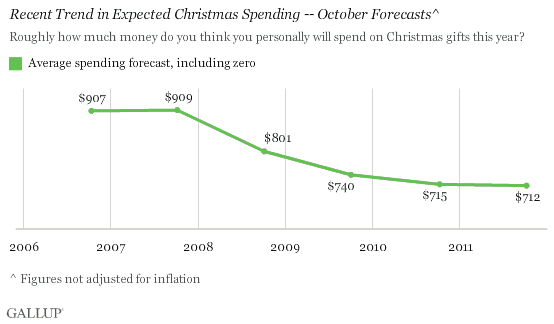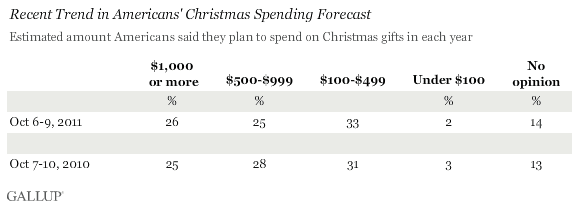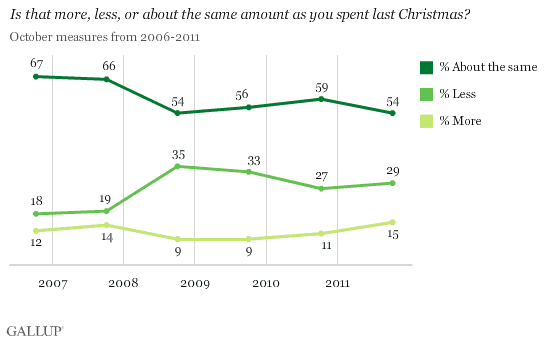PRINCETON, NJ -- Americans forecast they will spend $712 on Christmas gifts this year, nearly identical to the $715 they estimated they would spend on Christmas at this time last year.

More specifically, about one-quarter of Americans plan to spend at least $1,000 on gifts, another quarter say they will spend between $500 and $999, and about one-third will spend between $100 and $499. Very few plan to spend less than $100 while 14% are unsure.

Americans' Spending Intentions Unchanged From 2010
The poll, conducted Oct. 6-9, also shows little change compared with October 2010 in Americans' estimates of whether they will spend more or less on Christmas gifts than the year before. Roughly twice as many Americans say they will spend less rather than more on gifts this year (29% vs. 15%), while 54% say they will spend about the same.
Today's "spend less" figure is a bit lower than the 35% and 33% recorded in 2008 and 2009, respectively -- years in which there were actual declines in holiday retail spending, according to National Retail Federation data.

As can be seen in Gallup's full trend for the comparative spending question (see pdf at the end of this report), Americans almost always answer this question conservatively. The only exceptions have come in particularly robust economic years (such as 1998 through 2000), when the "spend more" and "spend less" percentages were about equal. In most measures, historically, the majority of Americans have said they will spend about the same on gifts as they did the year before.
Bottom Line
U.S. holiday retail spending rebounded somewhat in 2010 after three years of highly anemic sales. Thus, if consumers' 2011 Christmas spending intentions remain at 2010 levels, 2011 holiday retail spending could be flat, although at a modestly improved level over 2008 to 2009.
Consumer spending showed significant year-to-year growth in June and July, according to government retail sales data. However, Americans' economic confidence has since slumped to nearly match the extreme lows seen after the Wall Street financial crisis in 2008. Whether that will translate into restrained holiday spending remains to be seen, but Gallup Daily tracking already detects some belt-tightening in Americans' routine discretionary spending. Gallup will measure Americans' Christmas spending intentions again in November.
Survey Methods
Results for this Gallup poll are based on telephone interviews conducted Oct. 6-9, 2011, with a random sample of 1,005 adults, aged 18 and older, living in all 50 U.S. states and the District of Columbia.
For results based on the total sample of national adults, one can say with 95% confidence that the maximum margin of sampling error is ±4 percentage points.
Interviews are conducted with respondents on landline telephones and cellular phones, with interviews conducted in Spanish for respondents who are primarily Spanish-speaking. Each sample includes a minimum quota of 400 cell phone respondents and 600 landline respondents per 1,000 national adults, with additional minimum quotas among landline respondents by region. Landline telephone numbers are chosen at random among listed telephone numbers. Cell phone numbers are selected using random-digit-dial methods. Landline respondents are chosen at random within each household on the basis of which member had the most recent birthday.
Samples are weighted by gender, age, race, Hispanic ethnicity, education, region, adults in the household, and phone status (cell phone only/landline only/both, cell phone mostly, and having an unlisted landline number). Demographic weighting targets are based on the March 2010 Current Population Survey figures for the aged 18 and older non-institutionalized population living in U.S. telephone households. All reported margins of sampling error include the computed design effects for weighting and sample design.
In addition to sampling error, question wording and practical difficulties in conducting surveys can introduce error or bias into the findings of public opinion polls.
View methodology, full question results, and trend data.
For more details on Gallup's polling methodology, visit https://www.gallup.com/.
